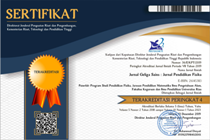Correlation Analysis of Learning Motivation with Cognitive Physics Learning Outcomes of High School Students on Static Fluids
Abstract
Physics is a branch of science that studies natural phenomena and phenomena. Learning physics is often considered difficult by students. This thinking can affect the results of student physics learning. This research purpose was to examine the relationship between students' motivation to learn physics and the physics learning outcomes of high school students on the subject of static fluid. The research method used is correlational quantitative. The sample for this research was students of class XI MIPA 4 at SMAN 1 Gedeg, Mojokerto Regency, which were determined using a purposive sampling area technique. Data collection was carried out by distributing questionnaires for students' motivation to learn physics with the ARCS indicator, while data collection on learning outcomes was carried out by means of a posttest. The analysis technique used in this study is descriptive statistical analysis and Pearson correlation analysis. The results showed that the average student’s motivation to learn physics was 3.49 and the students' physics learning outcomes were 67.34. The results of the Pearson correlation test obtained a value of Sig. (2-tailed) of 0.025 which means there is a correlation between variables. Based on these results, it can be concluded that there is a correlation relationship between students' physics learning motivation and student physics learning outcomes on the subject of static fluid. The Pearson Correlation value of 0.395 which is in the interval from 0.21 to 0.40 indicates a weak level of relationship between students' motivation to learn physics and students' physics learning outcomes.
Keywords
Full Text:
PDF (Bahasa Indonesia)References
Anderson, L.W., & Krathwohl, D. R. (2001). A Taxonomy for Learning, Teaching, and Assesing: A Revision of Bloom’s Taxonomy of Educational Objectives. Addison Wesley Longman, Inc.
Badaruddin, A. (2015). Peningkatan Motivasi Belajar Siswa Melalui Konseling Klasikal. Jakarta: CV Abe Kreatifindo.
Bloom, B.S., Engelhart, M. D., Furst, E. J., Hill, W. H., & Krathwohl D. R. (1956). The Taxonomy of Educational Objectives The Classification of Educational Goals, Handbook I: Cognitive Domain. New York: David McKay.
Hikmah, S. N., & Very, H. S. (2020). Hubungan Korelasi Motivasi Belajar dan Pemahaman Matematis Siswa Terhadap Hasil Belajar Matematika. Jurnal Ilmiah Matematika Realistik (JI-MR), 3(1), 7–11.
Himmah, F., Subiki, & Supeno, S. (2021). Pengembangan Modul Pembelajaran Fisika Sma Pokok Bahasan Fluida Statis Berbasis Potensi Lokal Pada Waduk Lecari Banyuwangi. ORBITA: Jurnal Kajian, Inovasi Dan Aplikasi Pendidikan Fisika, 7(2), 343. https://doi.org/10.31764/orbita.v7i2.5761
Latifah, N. K., Tomo, D., & Hamdani. (2022). Penyediaan E-Komik Fisika untuk Meningkatkan Hasil Belajar Peserta Didik pada Materi Gerak Lurus di MTs Negeri 1 Kayong Utara. Jurnal Geliga Sains, 10(2), 112-119.
http://dx.doi.org/10.31258/jgs.10.2.112-119
Kamila, N., Sri, H. B. P., & Lailatul, N. (2020). Penerapan Model Application of Step Instruction and Elaboration(APPOSITE) untuk Meningkatkan Hasil Belajar Kognitif Siswa SMA pada Materi Suhu dan Kalor. Journal of Natural Science and Integration, 3(2), 163-171.
Marlina, D., Kapur, K. S., Azzahra, N. I., & Desnita. (2019). Meta Analisis Pengaruh Penggunaan LKS Terhadap Keterampilan Berpikir Kritis Siswa SMA dalam Pembelajaran Fisika, 11(2), 1–8.
Multasyam, Yani, A., & Ma’ruf. (2016). Pengaruh Model Pembelajaran Langsung Terhadap Hasil Belajar Fisika Pada Siswa Kelas X SMA Handayani Sungguminasa Kabupaten Gowa. Jurnal Pendidikan Fisika, 4(3), 298–308. http://journal.unismuh.ac.id/index.php/jpf/article/view/328
Ratnawulan, E., & Rusdiana, A. (2015). Evaluasi Pembelajaran. Bandung: Pustaka Setia.
Sari, P. I., Gunawan, G., & Harjono, A. (2017). Penggunaan Discovery Learning Berbantuan Laboratorium Virtual pada Penguasaan Konsep Fisika Siswa. Jurnal Pendidikan Fisika Dan Teknologi, 2(4), 176–182. https://doi.org/10.29303/jpft.v2i4.310
Setiawan, M. A. (2017). Belajar dan Pembelajaran. Ponorogo: Uwais Inspirasi Indonesia.
Sofiuddin, M. B., Kusairi, S., & Sutopo. (2018). Analisis Penguasaan Konsep Siswa pada Materi Fluida Statis. Jurnal Pendidikan: Teori, Penelitian, Dan Pengembangan, 3(7), 1030. https://doi.org/10.17977/jptpp.v4i8.12664
Uno, H. B. (2021). Teori Motivasi dan Pengukurannya: Analisis di Bidang Pendidikan. Jakarta: PT Bumi Aksara.
Wahyuni, S. (2019). Identifikasi Miskonsepsi Peserta Didik Pada Konsep Fluida Statis di Kelas XI SMAN 5 Banda Aceh. Universitas Islam Negeri Ar-Raniry Banda Aceh.
Widoyoko, S. E. P. (2015). Evaluasi Program Pembelajaran: Panduan Praktis Bagi Pendidik dan Calon Pendidik. Yogyakarta: Pustaka Pelajar.
DOI: http://dx.doi.org/10.31258/jgs.11.1.35-42
Refbacks
- There are currently no refbacks.
Copyright (c) 2023 Fajar Bahari

This work is licensed under a Creative Commons Attribution 4.0 International License.
Jurnal ini terdaftar dan terindeks pada:
- Crossref
- Google Scholar
- Crossref
- Garuda
- Sinta
- Researchgate
- Dimensions
- Base
- Scilit
- OneSearch
- Road
- CiteFactor
- ResearchBib
- WorldCat



















